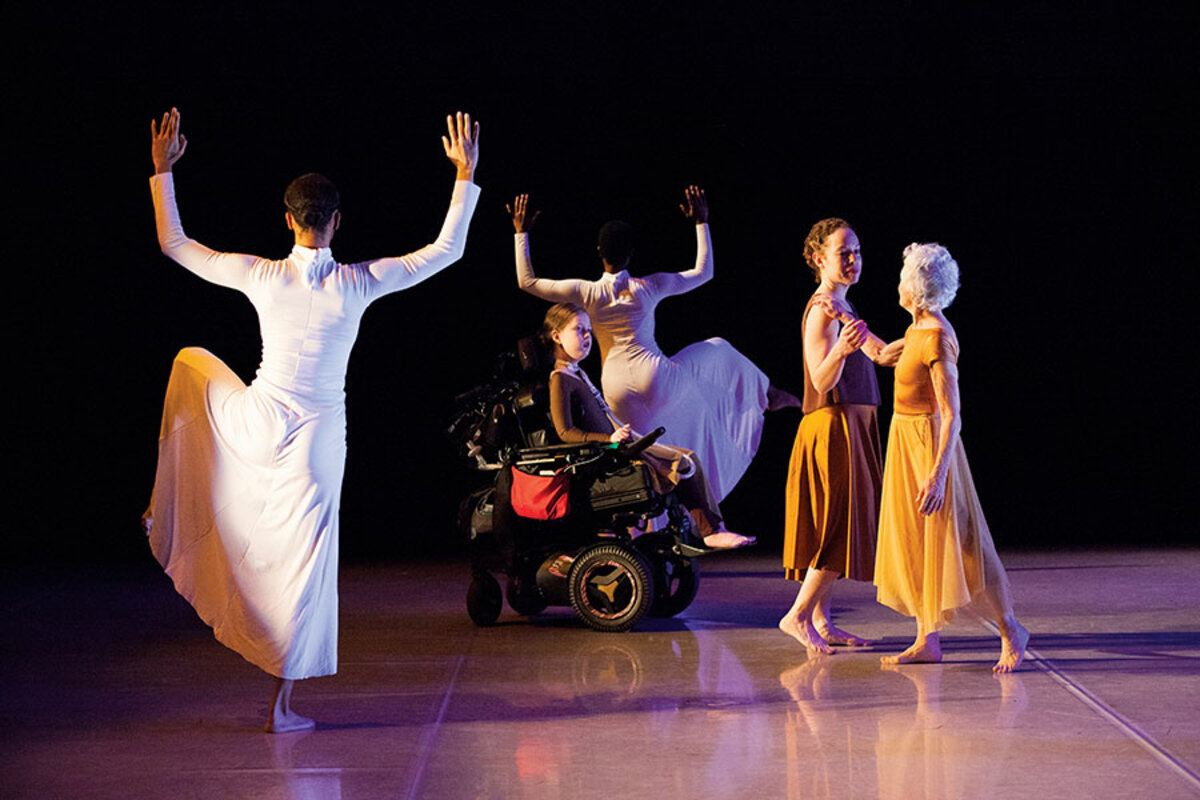At Born Dancing, different abilities – but all in harmony
Loading...
| New York
With a late afternoon glow filling the studio, dozens of dancers stretch and chat quietly. As the rehearsal starts with soft piano notes, their bodies form an ebb and flow, creating a sense of connection. But this rehearsal is less focused on well-worn repetitions of pirouettes and arabesques. Instead, it’s almost a fully fledged social experiment, offering a reinvention of who can dance.
This is Born Dancing, which welcomes both those with disabilities and non-disabled individuals. Some are children with learning disabilities. Other older participants are struggling with the physical effects of Parkinson’s disease. Some are professional dancers.
By the end of the piece at the rehearsal, the dancers have accomplished something markedly beautiful: an expression of ability and resilience, enriched by the unique contributions of each participant.
Why We Wrote This
A New York dance studio welcomes both those with disabilities and those without, creating performances informed by resilience and showcasing the experiences of people who are often overlooked.
“This is not a company that you’re in just for the challenge of the movement. It’s also the challenge of collaboration with such a broad range of people,” says Melissa van Wijk, founder and executive director of Born Dancing.
Ms. Van Wijk began Born Dancing in New York after years of teaching dance to children with disabilities. She had launched her efforts after realizing she had never seen a dancer in a wheelchair. Her company, which was a full-fledged reality by 2016, has a simple aspiration: to change the way that those with disabilities, from autism to physical impairments, are seen, taught, and told to move.
“Every dancer is made to feel beautiful,” says Madeline Charles, who has been with Born Dancing since its first production and also works with other dance companies. “There’s a range of ages and abilities, and we as professional dancers learn from this. They are telling us their own stories.”
Choreography is informed and guided by those who are often relegated to the background. The result is a dynamic, egalitarian environment.
“Everybody should have the opportunity to dance, and [Van Wijk] has this gift of elevating everybody’s stature,” says Patricia Beilman, a dancer in the production that Born Dancing put on in December. Ms. Beilman grew up taking ballet lessons, and after her condition was diagnosed as Parkinson’s disease, she rediscovered the appeal of dancing, attending lessons with the nonprofit Dance for PD.
“Performances help with stigma. When my friends see what I’m doing they say, ‘Oh, she has Parkinson’s, and she’s dancing. That’s pretty cool.’ ”
Van Wijk’s company has three main components, each with an aim. It’s getting children with disabilities involved in dance, it has an apprenticeship program for disabled teenagers to learn about careers in the performing arts, and it’s educating the next wave of professional dance instructors. These components coalesce in productions held about twice a year. The one in December featured about 30 dancers.
Parents travel from far and wide for the rehearsals each week. Ammie Johnson drives her 11-year-old son, Afadji, an hour and a half from Middletown, N.Y. Laurie McIntosh makes a three-hour trek from the Catskills so her daughter Ava can participate in her first professional dance production.
The program also enlists many children in District 75, New York City’s public schools for special-needs students. Too often, these kinds of students drop out and feel they aren’t equipped to enter the workforce. The opportunity for success is even smaller for those interested in the arts.
Diane Duggan is a retired dance therapist and educator from District 75. “There’s more equality than when I first came in [to the schools], but there needs to be much, much more,” says Dr. Duggan, who has taught in the master’s program for dance education at New York University. “It’s really vital for all children to be able to have dance.... Instead of being someone who struggles in class, they really get dance and enjoy it.”
For the children in the December production, Born Dancing holds great meaning. “I feel like this is my home; I love Born Dancing.... When I’m dancing, it’s like I’m putting a story together,” says 14-year-old Ava McIntosh, who has Down syndrome. Greta Baier feels the same way, saying the program creates a space where her talents are nurtured. “I feel more included here than at my school because they really make sure we’re participating and don’t just focus on kids that can walk,” says the 10-year-old, who uses a wheelchair because of a congenital muscular dystrophy.
“I really like the arts, [and] dancing is one of my favorite things to do. When I grow up, I want to go into the arts,” Greta adds.
The larger point of Born Dancing is to create such opportunities for disabled people now and in the future, both on and off the stage.
“The field [of disabled dance] is gaining recognition: Both the audience for the work has broadened, and the dance field itself is increasingly recognizing the value and artistry of these dancers and these companies,” says Simi Linton, co-director of Disability/Arts/NYC (DANC).
Van Wijk agrees. “I think that there’s been an evolution. A lot of people are thinking more about inclusion, integrated arts, and disability arts.”
That’s certainly true of the company’s professional dancers, some of whom may be among the next generation of choreographers and dance educators.
“It’s always been a dream for me to open a company of dancers with disabilities, and this process has been a huge learning experience for me,” Ms. Charles says. She was first inspired to this work growing up with a sister who uses a wheelchair, wanting to help create a different world for her.
Dominique Lockett, another professional dancer in the company, thinks the future looks bright for disabled dance and inclusion.
“By watching them and helping them learn – we’re not going against them, but coming to them. To have all the kids, adults, and teenagers being able to move as one, it has changed a lot of how I think about dance.”







